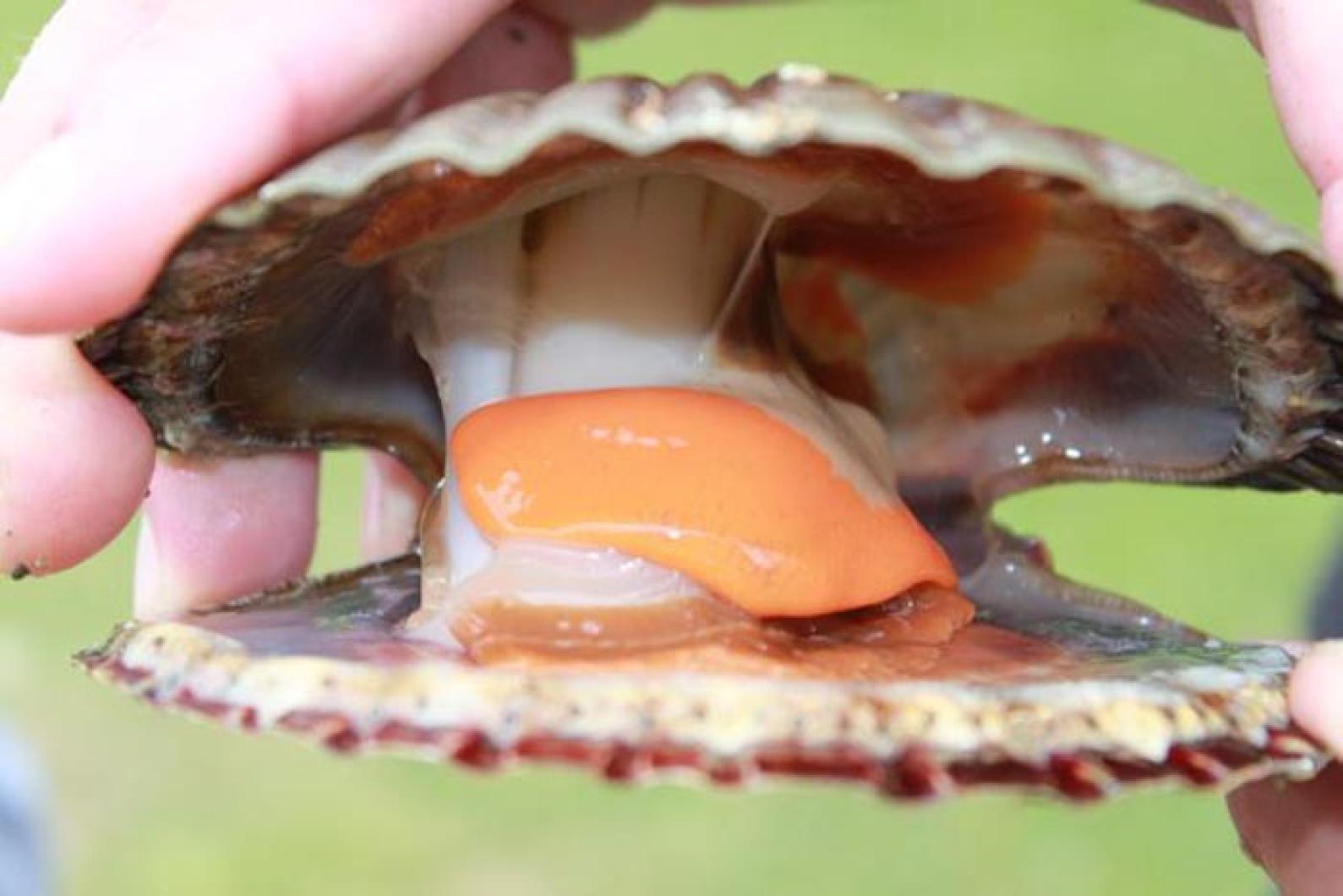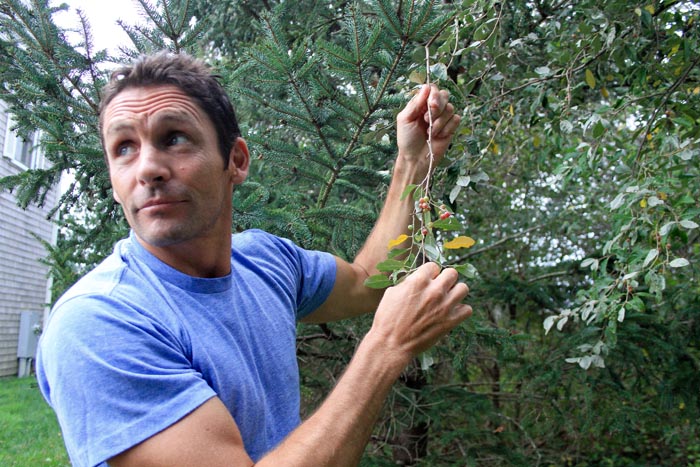For the wild food crowd, grocery shopping begins when you leave the supermarket. On the other side of those automatic sliding doors is a diffuse (and free) marketplace filled with geese, berries, turtles, seaweed, deer, scallops and basically anything else you can digest. This Sunday marks the second annual Martha’s Vineyard Local Wild Food Challenge, and organizer and chef Bill Manson has imported the resourceful philosophy of the hunter-gatherer from his native New Zealand. The contest takes place at the Rod and Gun Club in Edgartown, beginning at 4 p.m.
“Last year the Vineyard went nuts,” he said about the contest, which requires amateur and professional chefs alike to incorporate wild ingredients in their entree entries and rewards the more inventive submissions. “I wasn’t surprised, I suppose, but I thought, these guys are just like the gang at home.”
Last year Vineyarders created more than 30 dishes that ranged from the predictable, a selection of wild-caught seafood and venison, to the more adventurous such as snapping turtle.
“That one was bloody unusual, mate,” said Mr. Manson who enjoyed the dish with spiced chorizo. Last year’s winner, Dan Sauer of Aquinnah and 7a Foods, chose a similarly rare, if ubiquitous, ingredient: Canada goose, which he prepared sous-vide and confit style with a stinging nettles puree foraged from Chilmark and chicken-of-the-woods mushroom risotto, lemon sorrel, sea salt and a gastrique of autumn olives all from Aquinnah though he could have found the last ingredient anywhere, as the roadside berry bush is considered a nuisance in Island botanical circles. In fact, between Canada geese, snapping turtles and autumn olive, Mr. Manson says that eating wild provides a creative solution to managing invasive species.
Mr. Manson’s inspiration for the challenge, as well as his Vineyard connection, came from his decade living in Courchevel in the French Alps where he and his wife, Sarah, ran a mixed adventure tourism/culinary outfit.
“We combined food and well, adrenaline, really,” he said of the years he spent teaching clients to ski, snowboard, telemark and paraglide in the Savoie region. “We would have loads of Vineyarders come out and we’d flog them pretty hard on the hill and then feed them lots of yummies at night.”
The French locals, meanwhile, would regale the Mansons about the region’s traditional fare.
“In the springtime people would drop off little bags of morels, or they’d make this great liqueur called génépi,” he said.
The liqueur was made from a plant by the same name, and Mr. Manson was struck by the lengths to which locals would go to procure it.
“You have to go and climb through these craggy rocks to source this one little plant,” he said. “Things like that we were quite inspired by.”
When he returned to his seaside community in Eastbourne, New Zealand, he found a community that was more than receptive to his challenge to showcase the region’s abalone, spiny lobster, gravlax, sea trout, crabs, seaweed, jellyfish and from “the bush” rabbit and wild pig. When Kevin Crowell of Détente joined Mr. Manson as a judge for the New Zealand contest while on a trekking holiday, he convinced Mr. Manson to bring the contest to the Vineyard.
Two weeks ago Mr. Manson returned from Punkaharju, Finland, a “Hansel and Gretel” forest and lakeside town 300 kilometers east of Helsinki near the Russian border, where he just launched the third installment of his wild food challenge. There the winners prepared zilga grape leaves stuffed with barley and dill and wild anise hyssop spirit, along with a wild thyme cantuccini and a Bothnian Bay arctic bramble liqueur.
Incorporated in each of Mr. Manson’s challenges is a scoring system that rewards unusual ingredients and unusual effort, as well as taste and presentation equally. As a result, he says, it is close to a level playing field for those amateurs who are daring enough.
“We had one lass who was six months pregnant and she was walking a hunting dog up in the bush in New Zealand when her dog gets onto a pig,” he said. “She happened to take a knife with her as you do when you’re six months pregnant and got the pig and dragged it out of the bush. It wasn’t a big one but you’ve still got to get in there and get the Captain Cooker.”
Don’t be too daring though. Promotional material for the challenge warns, “If in doubt leave it out.” Incorporate the wrong wild mushroom in your dish, Mr. Manson warns, and a contestant could put the judges “in a casket” or leave them “spaced off their heads.”
Like any proud hunter-gatherer Mr. Manson can become cagey when discussing his favorite foraging haunts on the Vineyard where he has split time with New Zealand for the last ten years.
“There’s wild cress out by well I can’t really tell you the spots because everyone’s got their own little stash,” he said. “But there’s a place in Oak Bluffs on public land where there’s wild cress everywhere. You want to search near the streams in more gladed areas. The seashores are full of things like seabean, different sorts of seaweed. There’s duck, phezzie. Family licenses for scallops are open now I want to see whatever anyone can come up with.”
Mr. Manson says he is still learning from Islanders.
“I’ve been turned onto scup by the Portuguese out here, scup with chorizo, that sort of thing,” he said. “A lot of people think it’s a baitfish for bass which to me is just a crazy waste of beautiful scup.”
In 1879, revolted by the cuisine he experienced in his travels through Europe, Mark Twain penned a love letter to regional American cuisine. In A Tramp Abroad the author pined for an 81-course fantasy meal that included among other lost classics, Philadelphia terrapin soup, canvasback duck from Baltimore and prairie hens from Illinois all of which are now extremely rare species. On the Vineyard, and in Punkaharju and Eastbourne, Mr. Manson hopes his wild food challenges help to preserve native species.
“Part of what we’re doing is saying ‘Look, get out there, go into your environment a little bit deeper. Don’t just wing past it and then worry when the resources have all disappeared and you wonder why,’” he said. “If you’re in that environment you’re understanding and seeing firsthand how those resources are affected by us. Now if you don’t ever go, you don’t know. I mean, you can read about it and you can be a supporter of it but to really understand it you need to get out there. Then you start to think about your kids, and you start to think about what’s around and how good it is and how you want to keep it like that. You’ll be the first one to know when you can’t find your ingredients anymore.”
The Marthas’ Vineyard Wild Food Challenge begins at 4 p.m. on Sunday, Oct. 16, at the Martha’s Vineyard Rod and Gun Club in Edgartown and is open to everyone. For more information, visit localwildfoodchallenge.com.









Comments
Comment policy »